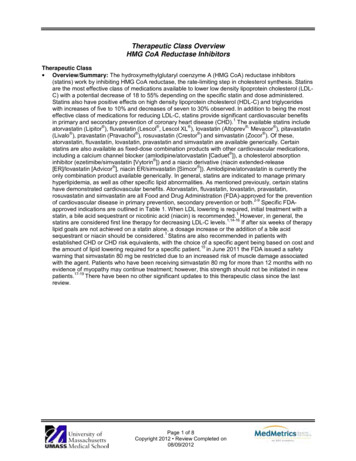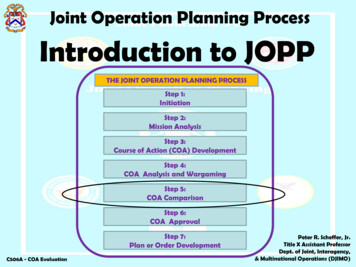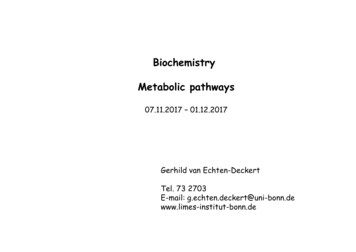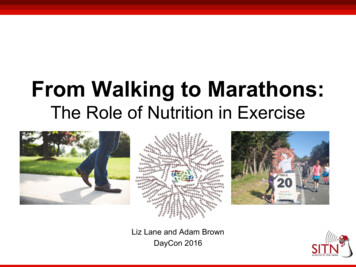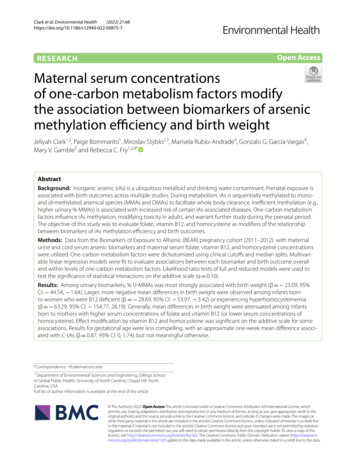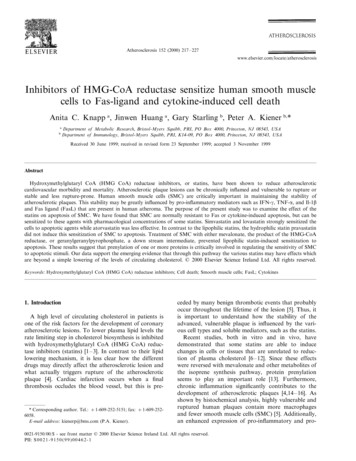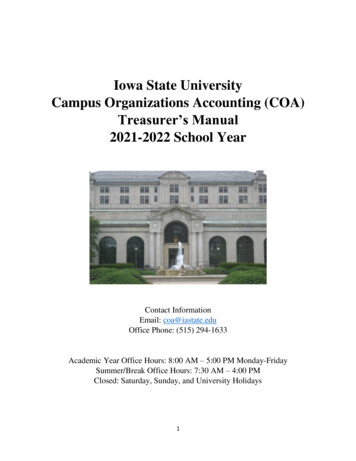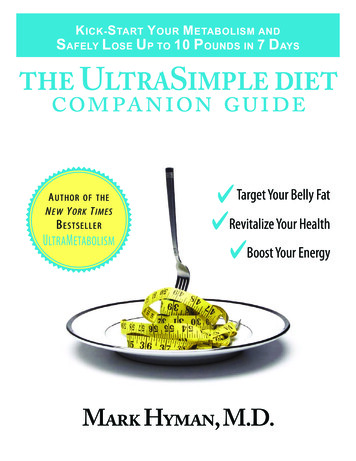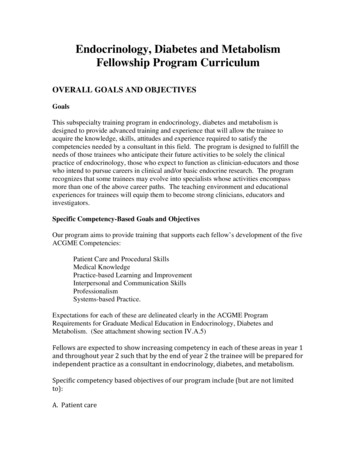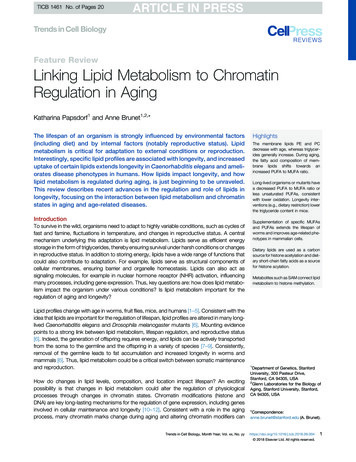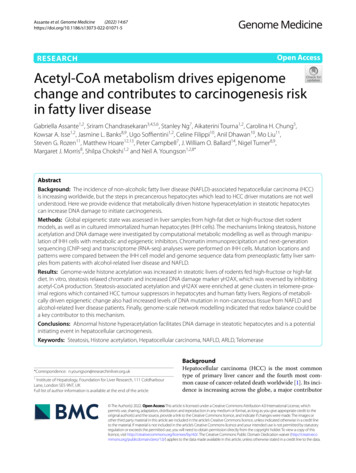
Transcription
(2022) 14:67Assante et al. Genome Open AccessRESEARCHAcetyl‑CoA metabolism drives epigenomechange and contributes to carcinogenesis riskin fatty liver diseaseGabriella Assante1,2, Sriram Chandrasekaran3,4,5,6, Stanley Ng7, Aikaterini Tourna1,2, Carolina H. Chung5,Kowsar A. Isse1,2, Jasmine L. Banks8,9, Ugo Soffientini1,2, Celine Filippi10, Anil Dhawan10, Mo Liu11,Steven G. Rozen11, Matthew Hoare12,13, Peter Campbell7, J. William O. Ballard14, Nigel Turner8,9,Margaret J. Morris8, Shilpa Chokshi1,2 and Neil A. Youngson1,2,8*AbstractBackground: The incidence of non-alcoholic fatty liver disease (NAFLD)-associated hepatocellular carcinoma (HCC)is increasing worldwide, but the steps in precancerous hepatocytes which lead to HCC driver mutations are not wellunderstood. Here we provide evidence that metabolically driven histone hyperacetylation in steatotic hepatocytescan increase DNA damage to initiate carcinogenesis.Methods: Global epigenetic state was assessed in liver samples from high-fat diet or high-fructose diet rodentmodels, as well as in cultured immortalized human hepatocytes (IHH cells). The mechanisms linking steatosis, histoneacetylation and DNA damage were investigated by computational metabolic modelling as well as through manipulation of IHH cells with metabolic and epigenetic inhibitors. Chromatin immunoprecipitation and next-generationsequencing (ChIP-seq) and transcriptome (RNA-seq) analyses were performed on IHH cells. Mutation locations andpatterns were compared between the IHH cell model and genome sequence data from preneoplastic fatty liver samples from patients with alcohol-related liver disease and NAFLD.Results: Genome-wide histone acetylation was increased in steatotic livers of rodents fed high-fructose or high-fatdiet. In vitro, steatosis relaxed chromatin and increased DNA damage marker γH2AX, which was reversed by inhibitingacetyl-CoA production. Steatosis-associated acetylation and γH2AX were enriched at gene clusters in telomere-proximal regions which contained HCC tumour suppressors in hepatocytes and human fatty livers. Regions of metabolically driven epigenetic change also had increased levels of DNA mutation in non-cancerous tissue from NAFLD andalcohol-related liver disease patients. Finally, genome-scale network modelling indicated that redox balance could bea key contributor to this mechanism.Conclusions: Abnormal histone hyperacetylation facilitates DNA damage in steatotic hepatocytes and is a potentialinitiating event in hepatocellular carcinogenesis.Keywords: Steatosis, Histone acetylation, Hepatocellular carcinoma, NAFLD, ARLD, Telomerase*Correspondence: n.youngson@researchinliver.org.uk1Institute of Hepatology, Foundation for Liver Research, 111 ColdharbourLane, London SE5 9NT, UKFull list of author information is available at the end of the articleBackgroundHepatocellular carcinoma (HCC) is the most commontype of primary liver cancer and the fourth most common cause of cancer-related death worldwide [1]. Its incidence is increasing across the globe, a major contributor The Author(s) 2022. Open Access This article is licensed under a Creative Commons Attribution 4.0 International License, whichpermits use, sharing, adaptation, distribution and reproduction in any medium or format, as long as you give appropriate credit to theoriginal author(s) and the source, provide a link to the Creative Commons licence, and indicate if changes were made. The images orother third party material in this article are included in the article’s Creative Commons licence, unless indicated otherwise in a credit lineto the material. If material is not included in the article’s Creative Commons licence and your intended use is not permitted by statutoryregulation or exceeds the permitted use, you will need to obtain permission directly from the copyright holder. To view a copy of thislicence, visit http:// creat iveco mmons. org/ licen ses/ by/4. 0/. The Creative Commons Public Domain Dedication waiver (http:// creat iveco mmons. org/ publi cdoma in/ zero/1. 0/) applies to the data made available in this article, unless otherwise stated in a credit line to the data.
Assante et al. Genome Medicine(2022) 14:67to this being the obesity epidemic and the concomitantincreases in non-alcoholic fatty liver disease (NAFLD). Atpresent NAFLD is estimated to affect around 25% of theworld’s population [2] and is the fastest growing causeof HCC in the USA, France and the UK [3]. Clinically,NAFLD presents as a spectrum which progresses fromsimple steatosis to non-alcoholic steatohepatitis (NASH)with accumulating inflammation and fibrosis culminating in cirrhosis and eventually liver failure. While HCCrisk is highest at the more severe stages, there is stillincreased risk in fatty livers without cirrhosis [4, 5]. HCCis a heterogeneous cancer and can display at least 6 subtypes, each with a different combination of characteristic mutations and transcriptomes [6]. The most commongenetic signature of HCC is mutation of the Telomerase(TERT) gene which is present in around 60% of cancersand is the earliest detectable of all the known mutations[7]. HCC-associated TERT mutations activate the gene,preventing telomere shortening which subverts cellularsenescence and apoptosis programmes thus setting cellson the path for immortalisation [7, 8]. The underlyingcauses for TERT mutation can include viral (hepatitisB or C) insertion, point mutations which alter localisedtranscription factor binding, or larger rearrangementswhich duplicate the gene or translocate the regulatorysequences of a more highly expressed gene to the TERTlocus [7]. However, the mutational forces which induceNAFLD-HCC are poorly understood. Oxidative stress isa strong candidate for generating mutations [9] but thereasons why TERT mutations are so much more prevalent than other mutations at the early stages of carcinogenesis is unknown.Diet and epigenetics are highly interlinked as themolecular substrates for epigenetic modifications are alsoproducts of intermediary metabolism [10]. This situationensures that there is constant communication betweenthe two processes, so that gene expression can be quicklymodified to meet the energy demands of the cell. Perhaps the best understood example of the link betweendietary macronutrients and epigenetics is histone acetylation. Acetyl coenzyme A (acetyl-CoA) is produced bythe breakdown of carbohydrates [11, 12] and fats [13] forcellular energy, as well as being the substrate for de novolipogenesis (DNL) and ketone generation. It also providesthe acetyl groups for histone acetylation, an epigeneticmodification which can decondense, i.e. ‘open-up’ chromatin to facilitate access to DNA for transcriptional orDNA repair proteins. In vivo measurements in rat haveshown that absolute acetyl-CoA levels are increased infatty liver [14]. In human NAFLD livers, acetyl-CoA fluxinto DNL, and oxidation in the tricarboxylic acid (TCA)cycle, have been shown to be upregulated, while ketogenesis is reduced compared to healthy liver [15].Page 2 of 16The importance of epigenetic changes in cancer progression is well established, particularly in the context ofchanges which alter the transcription of oncogenes andtumour suppressor genes [16]. Mutations in epigeneticmodifier proteins are commonly found in cancer, evenas the initiating mutation [17, 18]. The potential therapeutic opportunity of this relationship is currently beingtested in the context of histone acetylation with severalclinical trials of pharmacological inhibitors of the writers,histone acetyltransferases (HATs) and erasers, histonedeacetylases (HDACs) in a variety of cancers, includingHCC [19, 20]. These therapies aim to reverse epigeneticdysregulation in partially or fully developed cancers, aftercancer-promoting DNA mutations have occurred, ratherthan at the initial pre-mutational stages that promotecarcinogenesis. This restricted use of epigenetic therapiesis partly due to there being no previously reported examples of abnormal energy metabolism driving epigeneticdysregulation to initiate carcinogenesis. Consideringthe mechanistic links between metabolism, epigeneticsand cancer, we hypothesized that perturbed acetyl-CoAmetabolism and histone acetylation could be an unrecognized contributor to NAFLD pathology and HCC risk.We investigated this using cell culture and rodent modelsof hepatocyte steatosis, as well as a computational modellinking cellular metabolism and histone acetylation. Tosupport the existence of a common pathological mechanism in humans, data from the in vitro model was compared with mutational data from human preneoplasticlivers and HCC samples.MethodsAnimal workAll rodent experiments were approved by the University of New South Wales Animal Care and Ethics Committee (Project numbers ACEC 11/82B and 13/55B). Forthe high-fat diet treatment (HFD), male Sprague–Dawleyrats from the Animal Research Centre (ARC, Perth, Australia) were housed two per cage under a 12:12 h light/dark cycle and ad libitum access to water and experimental diets. Three-week-old rats were split into two groupswith equal average body weight (n 14/14). Control ratswere fed normal chow (energy: 11 kJ g 1, 12% fat, 21%protein, 65% carbohydrate; Gordon’s Stockfeeds, NSW,Australia) while the HFD group was provided with twocommercial HFD pellets, SF03-020 (20 kJ g 1, 43% fat,17% protein, 40% carbohydrate; Specialty feeds, GlenForest, WA, Australia) and SF01-025 (18.3 kJ g 1, 44%fat, 17% protein, 39% carbohydrate; Specialty feeds), aswell as normal chow. The rats were sacrificed between24 and 29 weeks of age. Animals were sacrificed afteranaesthesia induced by i.p. injection of 100 mg ketamine/kg body weight and 15 mg xylazine/kg body weight
Assante et al. Genome Medicine(2022) 14:67followed by decapitation. At sacrifice the difference inbody weight between the groups had increased so thatthe control group averaged s.d 535 67 g (range 451–631 g) and the HFD group 717 67 g (range 604–807 g),P 6.0 10 8 [21].For high-fructose diet (HF), 10-week-old C57BL/6 Jmice were purchased from the Australian Resource Centre (Perth, Australia). Mice were maintained in a temperature-controlled room (22 C 1 C) with a 12-h light/dark cycle and ad libitum access to water and experimental diets. After 1 week on a standard control ‘chow’ diet(71% of calories from carbohydrate as wheat/starch, 8%calories from fat, 21% calories from protein, 3 kcal/g;Gordon’s Specialty Stock Feeds, NSW, Australia), micewere randomly allocated to remain on the chow diet(C) or to receive a home-made diet enriched in fructose(FR; 35% of calories from fructose, 35% calories fromstarch, 10% calories from fat, 20% calories from protein, 3.1 kcal/g) ad libitum for 8 weeks. At sacrifice, thecontrol and fructose-fed mice had no body weight difference but liver triacylglycerol levels in fructose mice were225% the level of control mice p 0.001 [22].Western blots (immunoblotting)Histones were extracted from approximately 30 mg powdered liver on a Precellys (Sapphire Bioscience Australia)at 6 m/s for 30 s, in Triton Extraction Buffer (TEB: PBScontaining 0.5% Triton X 100 (v/v), sodium butyrate5 mM) using the Abcam Acid Extraction Histone extraction protocol for western blot. Briefly, after lysis, sampleswere centrifuged at 6500 g for 10 min at 4 C to spindown the nuclei and supernatant discarded; the pellet is resuspended in 0.2 N HCl, and histones are acidextracted overnight at 4 C on a rotator. The next-daysamples were centrifuged at 6500 g for 10 min at 4 Cto pellet debris. The supernatant (which contains histones) was neutralized with 2 M NaOH at 1/10 of supernatant volume. Equal amounts of protein lysate wereelectrophoresed through a 4–15% precast gel (CriterionTGX, Bio-Rad) for 45 min at 150 V in running buffer(25 mmol/l Tris base, 192 mmol/l glycine and 1% SDS,pH 8.3). Proteins were transferred via a semi dry transferprocess with a Trans Blot Turbo System (Bio-Rad) ontoPVDF membranes (Bio-Rad). Membranes were blockedin 4% BSA in TBS-Tween for 1 h, then incubated overnight at 4 C with primary antibodies used at 1:2000 dilution; Histone H4K16ac pAb (Active Motif 39167), totalhistone H3 (Abcam, ab1791), Histone H2A.X antibody#2595 (Cell Signaling) and Phospho-Histone H2A.X(Ser139) (20E3) Rabbit mAb #9718 (Cell Signaling). Themembrane was subjected to three 10-min washes withTBS-Tween and incubation with appropriate secondary antibody (Cell Signaling) in 2% skim milk blockingPage 3 of 16solution in TBS-Tween at room temperature for 1 h,followed by three 10-min washes with TBS-Tween. Fordetecting bands, membranes were exposed to Clarity Western ECL Substrate (Bio-Rad) and visualized ona Bio-Rad ChemiDoc XRS. Membranes were strippedusing Reblot Plus (10X) (Millipore) for 10 min at roomtemperature and were re-blocked prior to pan-H3 immunoblotting. Immunolabelled bands were quantitatedusing ImageJ 1.44p software.Cell cultureImmortalized human hepatocytes (IHH) were cultured under standard conditions using control mediaDMEM/F-12 (Sigma) without phenol red, 10% FBS (LifeTechnologies, 10,108–165), 1% PEN/STREP (Life Technologies 15,140–122), 0.1% L-Glutamine (Life Technologies 25,030–024), 0.02% dexamethasone (SigmaD49025MG) and 1 pM insulin human recombinant zinc(Life Technologies 12,585–014). For generating steatosis,cells were supplemented with oleic acid-albumin (SigmaO3008) (300 μM). After for 4 days, confluent cells weretreated with 200 μM etomoxir (Sigma E1905), 50 μMBMS 303,141 (Sigma SML0784), 5 μM garcinol (ThermoFisher 15,716,585), acetyl-CoA carboxylase (ACC) inhibitor firsocostat (GS-0976) (Selleckchem S8893) 50 nM,antioxidant supplement (Sigma A1345) 10 , methotrexate (Sigma M9929) 10 nM and 50 μM ACCSi—CAS508186–14-9 (Sigma 5,337,560,001) for 4 h at 37 C.Lipid droplets stainingIntracellular lipid droplet staining was performed withHCS LipidTOX Green Neutral Lipid Stain (ThermoFisher). After removing the incubation medium, thecells were fixed with a solution of 3.7% of formaldehyde(Sigma) supplemented with Hoechst 33342 (ThermoFisher) and incubated for 20 min at room temperature inthe dark. After aspirating the fixative solution, the cellswere washed twice with PBS without Ca/Mg (Life Technologies). LipidTOX neutral lipid stain diluted in PBSwas added to the cells and incubated for 1 h at room temperature in the dark at a final concentration of 1 . Cellimaging acquisition was performed by using GFP 488 nmand DAPI 355 nm on Cytation 5 Cell Imaging MultiMode Reader (BioTek).In situ DNAse I sensitivity assay: chromatin stateCSK buffer was made by dissolving Pipes/KOH (Sigma),NaCl (Sigma), Sucrose (Sigma), EGTA (Sigma) and MgCl2 (Sigma) in H 2O. Cover slides were coated for1 h with 20% w/v of fibronectin (Sigma) diluted in PBS(Life Technology) at room temperature. Next, cells wereplated on the coated cover slides, washed once withPBS and lysed in CSK buffer supplemented with 0.2%
Assante et al. Genome Medicine(2022) 14:67Triton X-100 (Sigma) and cOmplete Protease Inhibitor Cocktail (Sigma/Roche) for 5 min at room temperature. Once the incubated solution was removed, thecells were washed with CSK buffer and then were incubated in CSK buffer supplemented with 0.1% TritonX-100 (Sigma), cOmplete Protease Inhibitor Cocktail(Sigma/Roche) and 50 U/ml DNaseI (Sigma) for 20 minat room temperature. Cells were then washed with CSKbuffer, and the remaining DNA was stained using Hoechst 33342 (Thermo Fisher) at a concentration of 5 μg/mlin CSK buffer supplemented with 125 mM ammoniumsulfate (Sigma) and cOmplete Protease Inhibitor Cocktail (Sigma/Roche) for 5 min at room temperature. Cellswere washed in CSK buffer and fixed in 100% methanol(Sigma) for 5 min at 20 C. The methanol was removedand the CSK buffer was added before imaging nucleusacquisition by using DAPI 355 nm on Cytation 5 CellImaging Multi-Mode Reader (BioTek). The nucleus areaof cells was acquired by a mask function created on theMicroscope Software.Indirect ɣH2AX immunofluorescenceControl and steatotic cells were washed twice in PBS(Life Technology) after 4 h drug treatment. Next, cellswere fixed with 4% solution of formaldehyde (Sigma) for15 min at room temperature and washed twice in PBS.Then, cells were permeabilized with 0.25% Triton X-100(Sigma) for 10 min at room temperature, washed twice inPBS and incubated with 3% BSA (Sigma) for 1 h at roomtemperature. Cells were first incubated with anti-gammaH2A.X (phospho S139) antibody—ChIP Grade (Abcam)for 1 h at 37 C and then incubated with fluorochromeconjugated secondary antibody (Sigma SAB4600400)for 1 h at 37 C in the dark. Cells were then stained with1 μg/mL Hoechst 33342 (Thermo Fisher) for 10 min atroom temperature and the imaging acquisition was performed by using DAPI 355 nm and RFP 558 nm on Cytation 5 Cell Imaging Multi-Mode Reader (BioTek). Thepercentage of positive cells was calculated with a maskfunction created on the Microscope Software.ChIP and next‑generation sequencingChromatin was isolated from 20 million cells using theMagna ChIP A/G Kit (One-day chromatin Immunoprecipitation Kits, Merck) according to the manufacturer’sinstructions. Chromatin was sonicated with a Vibra-CellVCX750 probe sonicator (Sonics) for 3 pulses of 15 sseparated by 30-s intervals at 30% output. Fifty microliters of chromatin was immunoprecipitated with 5 μgantibody specific for anti-gamma H2A.X (phospho S139)antibody—ChIP Grade (Abcam) or with 5 μg antibodyspecific for histone H4K16ac (ActiveMotif ). In total,100–250 ng of isolated DNA (average size 500 bp) wasPage 4 of 16sent to Genewiz for sequencing in an Illumina HiSeq2 150 bp. Sequencing yield was 29–37 Mb per sample. Sequence analysis was also performed by Genewiz.Raw data are available to download [23]. Sequence readswere trimmed to remove possible adapter sequences andnucleotides with poor quality at 3 end (error rate 0.01)using CLC Genomics Server 9.0. Trimmed data wasthen aligned to reference genome for human genomehg38. During the mapping, only specific alignmentwas allowed. A total of 163–198 M reads were aligned(all 95%). Peak analysis for each sample was done usingthe Histone model algorithm. As a result, a list of peaks(p 0.05) was obtained from each treatment sample.Detected peak sequences were extracted and peak coverages were calculated. Total peak number from controlmedia samples were 2815 and 1291 from the H4K16acand ɣH2AX ChIP-seqs, respectively. Total peak numberfrom oleic acid-treated samples were 650 and 5912 fromthe H4K16ac and ɣH2AX ChIP-seqs, respectively.ChIP and quantitative PCR on cells and human liversSamples of human livers which had been rejected fortransplantation (1 healthy liver and 1 steatotic liver) wereacquired through the King’s College Hospital, London;ethics number for hepatocyte biology held by ProfessorDhawan and Dr Filippi is LREC protocol 1998–0249.Chromatin was isolated from 20 million IHH cells or40 mg of human fatty liver (using the EpiQuik Chromatin Immunoprecipitation Kit (Epigentek) according tothe manufacturer’s instructions for cells or tissues. Sonication on isolated chromatin was performed as for theChIP-seq for cells but with pulses increased to 4 for tissue. Real-time PCRs were performed in triplicate withprimers for TERT promoter, PTEN and TP53 by usingLuna Universal qPCR Master Mix (NEB – M0003) asSybrGreen Probe on an Ariamx Real-Time PCR System(Agilent). Primer sequences for qPCR were as follows:PTEN ChIP-qPCR Forward 5′-GAG TCG CCT GTC ACC ATT TC-3′PTEN ChIP-qPCR Reverse 5′-GCG C AC GGG AGG TTT AAA A-3′; TERTp ChIP-qPCR Forward 5′-GGA TTC GCG GGC ACA GAC -3′, TERTp ChIP-qPCR Reverse5′-AGC GCT GCC TGA AAC TCG -3′; TP53 ChIP-qPCRForward 5′-GTA CCA CCA TCC ACT ACA ACT ACA TGT3′, TP53 ChIP-qPCR Reverse 5′-GGC TCC TGA CCT GGA GTC TTC-3′.RNA sequencingIHH cells were grown in either control media, oleicacid-supplemented media or oleic acid-supplementedmedia with a 4-h treatment of the histone acetyltransferase inhibitor (HATi) garcinol prior to collection. Fourseparate replicates were performed for each group. TotalRNA was isolated from 8 million cells per sample using
Assante et al. Genome Medicine(2022) 14:67a Qiagen RNEasy Mini kit. Approximately 1 μg of RNAwas sent to Novogene UK for directional library preparation (with rRNA removal), Illumina NovaSeq PE150sequencing and bioinformatic analysis. Sequencing yieldwas 5–6 Gb per sample. Sequence reads were trimmedto remove adapter sequences, reads with uncertainnucleotides constituting more than 10%, or reads whichhad low-quality nucleotides (Base Quality less than 5)constituting more than 50% of the read. Trimmed datawere then aligned to the reference human genome hg38with HISAT2 [24]. Aligned read BAM files are available to download [23]. In total, 28–49 M reads uniquelyaligned from each sample (85–95% of all reads). Mapping information from all samples was combined andplaced as input into a Cufflinks assembler. Assembledtransfrags were then compared to the reference transcripts to identify known and novel genes. Differentialgene expression analysis between groups was performedwith DEseq2 [25]. GATK software was used to performmutation site analysis on sample data and Snpeff software used to annotate the variant [26]. Gene enrichmentanalysis was performed on significantly differentiallyexpressed genes at http:// www. geneo ntolo gy. org/ andhttps:// david. ncifc rf. gov/.Statistical analysis for wet‑lab workResults are expressed as mean SEM. Data were analysed using Student’s t test or one-way ANOVA, followedby post hoc LSD tests using GraphPad Prism.Mutation burden comparisonsThe ethics number under which the samples wereacquired for mutational burden comparisons and mutational signature extraction was 16/NI/0196 as approvedby the Cambridge University Hospitals NHS Foundation Trust. All biological samples were collected withinformed consent from Addenbrooke’s Hospital, Cambridge, UK. Comparisons between the number of SNVsdetected in a whole genome sequencing (WGS) datasetderived from human liver biopsies [26] between variousclinically annotated conditions were performed in the Rstatistical programming using the ggstatsplot package[27]. For all comparisons, the default non-parametrictest was used as defined by the software, while the Benjamini–Hochberg method was enabled to correct p-valuesfor multiple hypothesis testing. The normal liver donorswere 5 colorectal cancer patients with average KleinerFibrosis Scores of 0.8 and average BMI of 26.6, 19 NAFLDpatients with an average Kleiner Fibrosis Score of 3.2 andaverage BMI of 30.8 and 10 ARLD patients with an average Kleiner Fibrosis Score of 3.9 and average BMI of 26.1(Additional file 1: Liver Cohort Baseline Clinical Data).Page 5 of 16Mutational signature extractionUsing the same files as for the mutation burden comparisons, single base substitution signatures in 96-trinucleotide contexts was extracted using the mSigHdp (v1.1.2)and hdpx (v0.3.0) package in R. In total, 50,000 burn-initerations were used, while setting the following hyperparameters and posterior sampling variables: post.n 200,post.space 100, gamma.alpha 1, gamma.beta 20. Allother parameters were set to defaults. Cosine similaritywas calculated to compare the extracted mutational signatures to the compendium of single base substitutionCOSMIC signatures [28].Computational metabolic modellingGenome-scale metabolic models have been widely usedto predict the metabolic behaviour of various mammalian cell types using transcriptomics data [29, 30].Gene expression data from mouse hepatocyte AML12cells treated with fatty acids (Octanoate) from McDonnel et al. [13] was used as input to derive reaction fluxthrough the human genome-scale metabolic model(RECON1) [31]. The human orthologs of the lists ofup- and downregulated mouse genes were overlaid ontothe RECON1 model based on gene-protein-reactionannotations in the model. Reaction fluxes that best fitthe expression data while satisfying stoichiometric andthermodynamic constraints were determined using amodelling approach detailed in Shen et al. [32, 33]. Thisapproach maximizes flux through reactions that areupregulated while minimizing flux through those reactions that are downregulated using linear optimization.The exchange reactions for nutrients (i.e. glucose, aminoacids, fatty acids, vitamins and minerals) in the metabolicmodel were constrained based on media compositionused in this study (DMEM-F12 media with 500 μM oleicacid). For visualization, a z-score transformation wasperformed on the flux difference between control andtreatment groups, and the significance of the differencewas determined using a paired t-test. Reactions showingsignificant changes in flux (p-value 0.05) were visualized in the heatmap (excluding transport-, exchange- andpseudo- reactions).ResultsHistone acetylation and chromatin state is altered in liversteatosisTo test the hypothesis that histone acetylation levels areincreased in steatotic hepatocytes, we first examinedrodent and cell culture models of liver and hepatocyte steatosis. Using our established rodent models of NAFLD, wefound in both the mouse model of fructose diet-inducedliver steatosis (Fig. 1A) [22] and the rat model of high-fat
Assante et al. Genome Medicine(2022) 14:67Page 6 of 16Fig. 1 A Histone acetylation and γH2AX levels in livers of control and high-fructose diet mice. B Histone acetylation and γH2AX levels in livers ofcontrol and high-fat diet rats. Ci Lipid content of IHH cells cultured in control or oleic acid-supplemented media. Cii Representative fluorescencemicroscopy image of IHH cells cultured in control or oleic acid-supplemented media (blue nuclear stain and green lipid stain). D Nuclear areameasurement of IHH cells cultured in control or oleic acid-supplemented media after DNAse I treatment. Error bars are SEM. Histone westerns allgroups n 4, Lipidtox assay n 7/8, DNaseI Assay n 3. *P 0.05, ***P 0.001 in t-testdiet-induced steatosis (Fig. 1B) [21], an increased H4K16acetylation compared to control diet animals. To dissectthe mechanisms that link macronutrients and genomewide epigenetic state, we treated immortalized humanhepatocytes (IHH) with oleic acid for 4 days. Oleic acid isthe most common fatty acid in nature and is abundant indietary fats from plant or animal sources. This treatmentquadrupled intracellular lipid content (Fig. 1 Ci–ii). As afurther test for broad epigenomic change, we adapted amethod for assessing genome-wide nuclear condensation in these cells [34] and found that oleic acid treatmentsignificantly decondensed chromatin compared to cellsgrown in control media (Fig. 1D). These results supportedour hypothesis that steatosis is associated with extensivehistone acetylation and epigenomic change. The clinicalimportance of steatosis-associated epigenomic changeper se could be limited as there are a variety of effectivemethods for reduction of steatosis (such as dieting, bariatric surgery and anti-lipogenic drugs). However, we alsohypothesized that the ‘opening-up’ of chromatin couldincrease the exposure of DNA to mutagens such as reactive oxygen species (ROS), and DNA mutations couldpersist even after reversal of steatosis. In that case, theepigenomic change could be an indirect, yet clinically significant contributor to long-term liver damage and carcinogenesis in hepatocytes.Hepatocyte steatosis is associated with increased ɣH2AXwhich is reversed by inhibition of acetyl‑CoA productionWe assessed whether the global chromatin changes areassociated with DNA damage by performing immunofluorescence for ɣH2AX, a well-established marker of DNAdamage [35, 36] which is present at elevated levels in steatotic liver [37, 38]. Oleic acid treatment nearly doubled thepercentage of IHH cells which had high levels of ɣH2AX,compared to control media cells (Fig. 2A, B). A trend forincreased γH2AX was also seen in the rodent livers whichhad steatosis and increased histone acetylation (Fig. 1A, B).
Assante et al. Genome Medicine(2022) 14:67Page 7 of 16Fig. 2 A Average number of cells with high ɣH2AX after oleic acid or oleic acid plus metabolic inhibitor drug treatments (% compared to controlcells). B Representative ɣH2AX immunofluorescence images of control and oleic acid-treated cells (blue nuclear stain, pink ɣH2AX). Error barsare SEM. All groups n 6–8. *P 0.05, ***P 0.0001 in t-test of oleic vs oleic plus inhibitor groupsTo investigate whether the DNA damage in vitro wasdependent on histone acetylation, we inhibited the majorbiochemical pathways which produce acetyl-CoA, thesubstrate for histone acetylation. We found that the steatosis-associated ɣH2AX was reversed by a 4-h pharmacological inhibition of any of the major sources of acetyl-CoA(Fig. 2A, B). β-oxidation produces acetyl-CoA throughthe sequential breakdown of fatty acids. We reducedβ-oxidation with the carnitine palmitoyltransferase-1(CPT-1) inhibitor etomoxir. The ATP citrate lyase (ACLY)inhibitor (BMS-303141) prevents the production of acetylCoA from citrate, while acetyl-CoA synthetase (ACSS2)inhibition prevents production of acetyl-CoA from acetate.Inhibition of all these sources of acetyl-CoA had the similar effect of reducing the number of cells with high ɣH2AXto levels comparable with non-steatotic cells. These datasuggest that diet-induced acetyl-CoA levels are indeedassociated with DNA damage in steatotic hepatocytes.Genomic regions with highest increases of ɣH2AX levelsin steatotic hepatocytes are clustered and contain genescommonly mutated in HCCWe next sought to identify which regions of the genomeexperience steatosis-associated increased ɣH2AX as thatwould identify which genes and biological processescould be disrupted by DNA damage. We performedchromatin immunoprecipitation with anti-H4K16ac andanti-ɣH2AX antibodies and next-gener
Diet and epigenetics are highly interlinked as the molecular substrates for epigenetic modications are also products of intermediary metabolism [10]. is situation ensures that there is constant communication between the two processes, so that gene expression can be quickly modied to meet the energy demands of the cell. Per-
